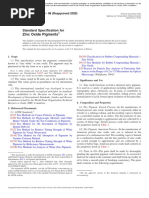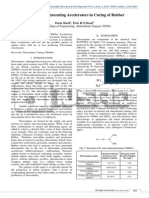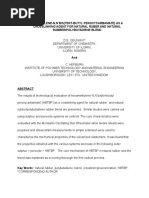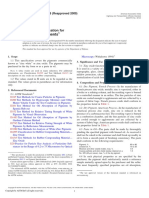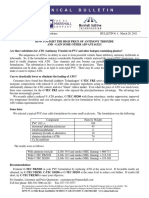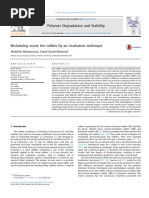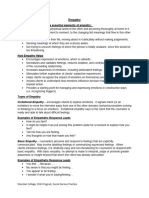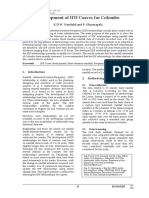Reemplazo de TMDT para Nitrosaminas
Reemplazo de TMDT para Nitrosaminas
Uploaded by
laura rojasCopyright:
Available Formats
Reemplazo de TMDT para Nitrosaminas
Reemplazo de TMDT para Nitrosaminas
Uploaded by
laura rojasOriginal Title
Copyright
Available Formats
Share this document
Did you find this document useful?
Is this content inappropriate?
Copyright:
Available Formats
Reemplazo de TMDT para Nitrosaminas
Reemplazo de TMDT para Nitrosaminas
Uploaded by
laura rojasCopyright:
Available Formats
IJSRD - International Journal for Scientific Research & Development| Vol.
1, Issue 3, 2013 | ISSN (online): 2321-0613
Replacing TMTD with Nitrosamine Free TBzTD- Accelerator in Curing
of Rubber
Parin Sheth1 Prof. Rupande N. Desai2
1, 2
L. D. College Of Engineering, Ahmedabad, Gujarat, INDIA
Abstract—Nitrosamines are generated during the mixing,
II. WHY BUTYL RUBBER
vulcanisation and storage of rubber articles. The major
source of Nitrosamine in Rubber products is amine Main Application of IIR (Butyl Rubber) includes
containing accelerators. TMTD is very widely used as a Automobile Tubes
primary and sulphur donor-standalone accelerator in Pharmaceutical Elastomeric Components
traditional sulphur curing systems. Due to secondary amine Medical and Surgical Tubing
contents in TMTD, it produces Nitrosamine during its use. Human exposure to these products are very wide and
TBzTD is again of same thiuram group accelerator but some time in very critical conditions.
without secondary amine, which results into Nitrosamine
free cure. The experiment to replace TMTD from III. BUTYL RUBBER (IIR)
conventional Butyl rubber recipe was carried out to study
and compare various physical properties of the Vulcanisate. Copolymer of Isobutylene with small amount of
Isoprene.
Keywords: Nitrosamine, Curing of Rubber, TMTD, TBzTD Isoprene provides double bonds which allow rubber to
be vulcanised with Sulphur and other vulcanising
I. INTRODUCTION agents.
To date, Germany leads the world in legislation and the Level of unsaturation (double bonds) is usually quoted
elimination of nitrosamines in the work place. In its in mol% i.e. numbers of unsaturated sites for every
hundred monomer units in chain.
“Technical Rules for Dangerous Substances” (TRGS 522),
eight suspected carcinogenic nitrosamines are listed that are Commercial butyl rubber have 0.5% to 3.0% of
commonly used in cure systems by the rubber industry unsaturation in contrast to unsaturation of NR and BR
(Table 1).4 Additionally, the TRGS 522 sets the following (100%),SBR(86%),and NBR (70% in 30%ACN
content)
restrictions;
2.5 μg/m3 for vulcanization / following production steps / This requires less quantity of curatives but more of
warehousing of technical rubber goods. efficiency (Ultra-fast).
1.0 μg/m3 for production steps before vulcanization and
warehouses. IV. CURING SYSTEMS FOR BUTYL
Slowly, the United States and Canada are Most widely adopted: Sulphur and Sulphur donor Curing
beginning to regulate nitrosamines. Two of the “Big Three” systems.
companies have set Engineering Specifications limiting, or There are four classes of common rubber
eliminating, their use in automotive rubber parts. Both have accelerators that during the curing process form reactive
published specifications that require a supplier to list the intermediate structures that contain secondary amines. If
level of nitrosamines present in the rubber parts. these intermediates react with nitrosating agents,
Table shows a list of countries that have set limits nitrosamines can be formed. These four classes of rubber
in the amount (measured in ppb) of nitrosamines and their accelerators are:
precursors that can be extracted from baby bottle nipples Dithiocarbamates
and pacifiers. Sulfenamides
Sulfur Donors
Nitrosamin
Country es (ppb Precursors (ppb max) Thiurams
max.)
Canada 10 Not regulated Quinoid systems: Very fast curing used for wire insulation
Germany 10 200 in continues vulcanization.
Netherlands 1 20
U.S.A. 20 Not regulated Resin Curing systems: Dimethylol Phenol Resins systems
Table 1: Nitrosamine limits are very slow and require very high curing temperatures.
Considering these rapidly developing standards rubber
chemist need to develop more and more tools. The Sulphur Curing Systems for Butyl:
Conventional Acceleration system used for sulphur or
purpose of this paper is to provide options for the
production of rubber products, with testing and
evaluating the TBzTD as a compounding alternative that sulphur donor curing of butyl rubber includes ultra-
eliminate the production of nitrosamines. In particular, accelerators like
for replacement of TMTD.
All rights reserved by www.ijsrd.com 532
Replacing TMTD with Nitrosamine Free TBzTD- Accelerator in Curing of Rubber
(IJSRD/Vol. 1/Issue 3/2013/0033)
a) Thiurams: slabs to be molded. This was accomplished by using the
The thiurams are secondary accelerators used in a rubber procedure as outlined in ASTM D3182. The ASTM
formulation at low phr levels to “tweak” the cure system to a Standard tests that were performed on each compound are
desired rate of cure. Although the thiurams are not as fast as identified in below table.
the dithiocarbamates, thiurams act as both an accelerator and Test ASTM Method
as a sulfur donor. Examples of common thiurams include Rheology (ODR with 1.5º arc@180 ºC for 15
DPTT, TBTB, TETD, TMTD, and TMTM D 5289
minutes
Mooney viscosity, MS 1+4 (121 ºC) D 1646
b) Sulphenamides: Mooney viscosity, MS 1+T5 (121 ºC) D 1646
Hardness, Shore A D 2240
The sulfenamides are primary accelerators that are used at Tensile, Elongation and Modulus D 412
low phr levels in a rubber compound and can influence not Table. 2: Physical Test and ASTM Methods
only the rate of cure, but also the scorch safety of the
compound. The specimens were also subjected to chemical testing for
Due to this nature, the sulfenamides have been Nitrosamine generation and identifications.
termed fast-delayed action accelerators. A feature of the The instrument used for these analyses, the
sulfenamides is that three of them are based on morpholine GC/TEA (gas chromatograph/thermal energy analyzer), is
and can generate the regulated nitroso-morpholine. They are specifically designed to detect only N-nitrosamines and to
MBSS, OBTS and OTOS (Cure-Rite® 18). However, there omit the signals produced by other types of compounds that
are three sulfenamides that do not produce regulated may interfere with the analysis. The GC/TEA (Thermo
nitrosamines. These include CBS, DCBS and TBBS. Scientific, USA) is more practical for volatile N-
nitrosamines. The volatile N-nitrosamines are of most
c) Dithiocarbamates: concern to the rubber industry and are the focus of the
German regulation.
The dithiocarbamates are secondary accelerators that are
used at low phr levels in a rubber compound to “tweak” the
cure system to a desired rate of cure. Examples of VII. EXPERIMENTAL FORMULATIONS OF BUTYL
dithiocarbamates include ZDBC, ZDMC, ZEPC, Z5MC, RUBBER
SDMC, LDMC, NDBC, BDMC, CDMC, ZDEC, TDEC, Recipe 1.0 1.1 1.2 1.3
etc. Almost every dithiocarbamate has the ability to form a Butyl Rubber 1675N 100 100 100 100
Zinc Oxide 4.0 4.0 4.0 4.0
regulated nitrosamine in the presence of a nitrosating agent. Kaolin 100 100 100 100
Paraffinic oil P-25 5.0 5.0 5.0 5.0
Suggested Thiuram for Nitrosamine free curing: Titanium Dioxide 4.0 4.0 4.0 4.0
Carbon HAF 0.5 0.5 0.5 0.5
TBzTD: Tetrabenzylthiuram disulphide TMTD (Lanxess) 1.0 0.0 0.0 0.0
MBT (Lanxess) 0.5 0.0 0.25 0.5
Sulphur 1.5 1.5 1.5 1.5
TBzTD (Robac) 0.0 1.5 1.5 1.5
Physical Properties Analysis:
Recipe 1.0 1.1 1.2 1.3 1.4
Compound
Viscosity ML 79 78 79 78 78
1+4 (100c)
Mooney scorch
Fig. 1: TBzTD ML 1+t5 @125c 12 >25 >25 >25 >25
(min)
V. EXPERIMENTAL WORK Rheometer
12.24 12.39 12.30 12.35 12.38
Cure@180c ML
Design and Process various compositions.
Methodology Rheometer
29.22 31.28 28.68 29.34 29.25
Cure@180c MH
Testing and Evaluation of various Physical and Rheometer
Cure@180c t5 140 360 240 200 210
Chemical Properties of the Vulcanisate formed using (sec)
Nitrosamine Free TBzTD Accelerators Systems and Rheometer
compare the physical properties of Vulcanisate with Cure@180c t90 360 720 460 420 440
(sec)
conventional TMTD based recipe.
Scope in this paper is limited to accelerators useful for
Curing at 170c
5 6 6 6 6
(min)
Butyl rubber i.e. TBzTD. Hardness Shore A
42 38 39 40 40
, 3”
Modulus @100%
VI. COMPOUNDING AND TESTING 1.8 1 1.1 1.3 1.2
elongation (MPa)
A rubber compound was created with each test formulation Modulus @300%
2.4 1 1 1.1 1.1
by adding the corresponding cure system into a master batch elongation (MPa)
Tensile Strength
on a two roll mill. End passes and cross cuts were (MPa)
9 7 7.2 7.7 7.5
performed. Following mixing, several physical tests were Ultimate
790 910 885 900 900
performed on the rubber compound. Some tests required elongation (%)
Cured @170c for 10 12 12 12 12
All rights reserved by www.ijsrd.com
533
Replacing TMTD with Nitrosamine Free TBzTD- Accelerator in Curing of Rubber
(IJSRD/Vol. 1/Issue 3/2013/0033)
Compression set related laws become easy and purposeful. Considering the
(min) above facts rubber technologist will require more and more
Set 24h at 100c
(%)
33 50 46 40 40 tools in future to meet the stringent environmental and
Set 70h at 70c health risk related guidelines. TMTD, which is widely used
36 50 45 40 40
(%) in Butyl Rubber curing accelerator systems, can be replaced
Table. 3: Physical Property Analysis with TBzTD and ZAT type accelerators with a slight tweak
in secondary accelerator type and level in the curing system.
Physical Properties of This review of accelerator systems will provide insights of
Nitrosamine formation and possible alternative to
Vulcanisates conventional butyl rubber curing systems. Future works on
1000 secondary accelerator and its synergy with the thiophosphate
and thiurams other booster chemicals need to be carrying
900 out to collect more date to provide more alternatives.
800
700 REFERENCES
600 [1] Schuster R.H., Casselmann H., Foller, F., Kautschuk &
500 Gummi Kunstsoffe, Vol. 41 10, 1988, pgs. 971-973.
[2] “Environmental Guidelines and Regulations for
400
Nitrosamines: A Policy Summary.”, Source: Internet:
300 www.tcmda.com/Global/.../MIT%20nitrosamines%20r
200 eport%20final.pdf
100 [3] Chris Keen and others, “A small survey of exposure to
rubber process dust, rubber fume and N-nitrosamines”
0
Modulus @100% elongation…
Modulus @300% elongation…
Compound Viscosity ML 1+4…
Mooney scorch ML 1+t5…
Cured @170c for Compression…
[4] L. C. Goss Jr.,* S. Monthey, H.-M. Issel, “Review And
Tensile Strength (MPa)
Set 70h at 70c(%)
Hardness Shore A , 3”
Ultimate elongation (%)
Set 24h at 100c (%)
Rheometer Cure@180c t5 (sec)
Rheometer Cure@180c MH
Rheometer Cure@180c t90 (sec)
Rheometer Cure@180c ML
The Latest Update Of N-Nitrosamines In The Rubber
Industry; The Regulated, The Potentially Regulated,
And Compounding To Eliminate Nitrosamine
Formation”, Rubber Chemistry And Technology Vol.
79.
[5] Lena S.Jonsson, “N-Nitrosamines in the Southern
Swedish Rubber Industries - Exposure, Health Effects,
and Immunologic Markers. Division Of Occupational
And Environmental Medicine, Lund University
Hospital, SE-221 85 Lund, Sweden”, Source: Internet
[6] Hajdasz, David, “Analysis Of N-Nitrosamines In
Compounds”, Rubber World-Jan 1, 1992
Sample # 1.0 Sample #1.1 sample #1.2 [7] Chris Keen, “A small survey of exposure to rubber
Sample # 1.3 Sample # 1.4 process dust, rubber fume and N-nitrosamines”,RR819-
HSE,Source: Internet
Fig. 2: Physical Properties of Vulcanisates [8] K. Rostkowska, K. Zwierz, A. Różański, J. Moniuszko
Jakoniuk, A. Roszczenko, “Formation and Metabolism
Chemical Properties Analysis:
of N-Nitrosamines”, Polish Journal of Environmental
Nitrosamine generation form the above recipes are evaluated
Studies Vol. 7, No. 6 (1998), 321-325
using GC/TEA instrument. No traces of nitrosamine found
[9] An Overview of Environmental Issues for Rubber
in TBzTD based curing systems.
Industries .Source: Internet: http://www.chemtech-
online.com/events/chemtech/2010/01/an-overview-of-
environmental-issues-for-rubber-industries.php
[10] Li H, Jönsson BAG, Lindh CH, Albin M, Broberg K,
“N–nitrosamines are associated with shorter telomere
length”, Scand J Work Environ Health 2011;37(4):316-
324 doi:10.5271/sjweh.3150
[11] P. J. Nieuwenhuizen And J. Reedijk, “Thiuram- And
Dithiocarbamate-Accelerated Sulfur Vulcanization
From The Chemist's Perspective; Methods, Materials
And Mechanisms Reviewed”, Rubber Chemistry And
Fig. 3: Chromatogram Analysis of Sample #1 Technology Vol. 70
[12] Product Manual and Brochure of Thermo Scientic
VIII. CONCLUSION Instruments GC Ultra-DSQII.
The awareness and developments of the sophisticated [13] Rein Chemie Technical Reports and products broucher.
technology to identify the traces of Nitrosamine, the
implementation of stringent environmental and health risk
All rights reserved by www.ijsrd.com
534
Replacing TMTD with Nitrosamine Free TBzTD- Accelerator in Curing of Rubber
(IJSRD/Vol. 1/Issue 3/2013/0033)
[14] Haley, Elizabeth Ann, “The application of the thermal in Environmental and Food Matrices”, BARC
energy analyser to the analysis of nitrosamines and Newsletter
organic nitrates”, Durham E-Theses. [33] “Nitrosamine Analysis by Gas Chromatography and
[15] Seeberger, D.B., “A new safe thiuram, TBzTD.”, Agilent 255 Nitrogen Chemiluminescence Detector
Rubber World, Aug 1, 1990. (NCD)”, Technical Review, www.agilent.com/chem
[16] Bryan G. Willoughby And Keith W. Scott, [34] Eleno Rodrigues Vieira*, Nilso José Pierozan and
“Nitrosamine Formation In Rubber: I. Influence Of Viviane Lovison, “Determination of N-nitrosamines
Mixing History”, Rapra Technology Ltd. and N-nitrosables Substances in Rubber Teats and
[17] Bryan G. Willoughby and Keith W. Scott, “Nitrosamine Sothers by GC-TEA”, Brazilian Archives of Biology
Formation in Rubber: II. Influence Of Mixing History”, and Technology, Vol.49, Special : pp. 73-77, January
Rapra Technology Ltd 2006
[18] Robert W. Layer ,Dwjght W. Chasar, “Minimizing [35] Kane Ikeda , Kenneth G. Migliorese, “Analysis Of
Nitrosamines Using Sterically Hindered Thiuram Nitrosamines In Cosmetics”, J. Soc.Cosmet. Chem.,4 1,
Disulfides/Dithiocarbamates”, The B. F. Goodrich 283-333 (September/October 1990)
Company [36] “Determination Of Nitrosamines In Drinking Water By
[19] H.M.Leeper, C.L.Gable, J.J.D'amico, Solid Phase Extraction And Capillary Column Gas
C.C.Tung, “Improved Resilience In Butyl Rubber Chromatography With Large Volume Injection And
Through Chemical Modification”, Monsanto Chemical Ionization Tandem Mass Spectrometry
Chemical Company (Ms/Ms)”, EPA Document #: EPA/600/R-05/054,
[20] Abi Santhosh Aprem, Kuruvilla Joseph, Sabu Thomas, National Exposure Research Laboratory Office Of
“Recent Developments In Crosslinking Of Elastomers”, Research And Development U.S. Environmental
Rubber Chemistry And Technology Vol. 78 Protection Agency Cincinnati, Ohio 45268
[21] Brendan Rodgers, Scott Solis, Nitin Tambe, Bharat B. [37] IEAGHG, “Seminar on Control of Nitrosamine
Sharma, “Alkylphenol Disulfide Polymer Accelerators formation in CO2 Capture Plant: Report on Meeting”,
And The Vulcanization Of Isobutylene Based 2011/05,June,2011
Elastomers”, Rubber Chemistry And Technology Vol.
81
[22] K. Rostkowska, K. Zwierz, A. Różański, J. Moniuszko-
Jakoniuk, A. Roszczenko, “Formation And Metabolism
Of N-Nitrosamines”, Polish Journal of Environmental
Studies Vol. 7, No. 6 (1998), 321-325
[23] Analysis of nitrosamines -
www.analytics.currenta.com.html
[24] Arising Challenges For Tire / Innerliner Formulators,
http://www.specialchem4polymers.com/resources/print.
aspx?id=2859
[25] Dr. Noelle E. Selin, “Environmental Guidelines And
Regulations For Nitrosamines: A Policy Summary”,
http://mit.edu/selin/
[26] Nitrosamines In Rubber: Environmental Issues And
Alternatives
Http://Www.Specialchem4polymers.Com/Resources/Pr
int.Aspx?Id=494
[27] Nitrosamine Solutions, Robac Chemicals
[28] Scientific Committee On Consumer Products (Sccp),
“opinion On The Presence And Release Of
Nitrosamines And Nitrosatable Compounds From
Rubber Balloons”,
[29] Jablonowski, Thomas L., “Tbztd And CBBS -
Alternative Accelerators For Reducing Nitrosamine
Generation.”, Rubber World, Aug 1, 1992
[30] Cristina Bergmann, Dietmar Hoff, Hans-Martin Issel,
Martin Saewe, “Avoiding Hazardous Vulcanization
Fumes In Rubber Processing”, Technical Report 78,
Rein Chemie
[31] What About Banned Molecules?
Http://Www.Specialchem4polymers.Com/Resources/Pr
int.Aspx?Id=3139
[32] S. Mahapatra, R.M. Tripathi, S. Bhalke and S.
Sadasivan, “GC-MS in Combination with Solid Phase
Micro Extraction for Determination of N-Nitrosamines
All rights reserved by www.ijsrd.com
535
You might also like
- Steven Pinkers The Sense of StyleDocument4 pagesSteven Pinkers The Sense of StylePeace Mantra100% (2)
- Astm D2425-19Document14 pagesAstm D2425-19RegianeNo ratings yet
- Vulcanization and AcceleratorsDocument35 pagesVulcanization and AcceleratorsJatin Darve100% (1)
- 029 Butyl Rubber CompoundsDocument6 pages029 Butyl Rubber Compoundsrossifam777100% (1)
- Zinc Oxide Pigments: Standard Specification ForDocument2 pagesZinc Oxide Pigments: Standard Specification ForMadhavanNo ratings yet
- X y Xy x2: I. Activity #1Document2 pagesX y Xy x2: I. Activity #1Jariel CatacutanNo ratings yet
- Nitrosamine Generating Accelerators in Curing of RubberDocument3 pagesNitrosamine Generating Accelerators in Curing of RubberkarlosmpNo ratings yet
- Toaz - Info d4818 PRDocument4 pagesToaz - Info d4818 PRAvinash SandilyaNo ratings yet
- Overview of Primary Accelerators in RubberDocument7 pagesOverview of Primary Accelerators in RubberSuchismita Sahoo100% (1)
- AcceleratorsDocument8 pagesAcceleratorsAkash S nathNo ratings yet
- 444951-None-E011b86d 231102 165601Document9 pages444951-None-E011b86d 231102 165601sinh phạm vănNo ratings yet
- Accelerator and AntiozidantDocument45 pagesAccelerator and Antiozidantvinod kumarNo ratings yet
- 1-Introduction: 1.1 - BlendingDocument3 pages1-Introduction: 1.1 - BlendingMehroz AnjumNo ratings yet
- Characterization of Additives in EPDM PDFDocument17 pagesCharacterization of Additives in EPDM PDFmuhammad duriNo ratings yet
- Blending of NR BR EPDM by SIDEWALLDocument26 pagesBlending of NR BR EPDM by SIDEWALLTUNGNo ratings yet
- 2017Document12 pages2017ਸੁਖਬੀਰ ਸਿੰਘ ਮਾਂਗਟNo ratings yet
- Astm D-7558-09Document5 pagesAstm D-7558-09Phạm Thu HuyềnNo ratings yet
- MorDocument3 pagesMorBharat ChatrathNo ratings yet
- 5 Rhenocure TMTD CDocument3 pages5 Rhenocure TMTD CKeremNo ratings yet
- Product Data: Turbinol XDocument2 pagesProduct Data: Turbinol XdedyhidNo ratings yet
- Thermogravimetry and Swelling Characteristics Af NBR/EPDM Blends With Some CompatibilizersDocument8 pagesThermogravimetry and Swelling Characteristics Af NBR/EPDM Blends With Some CompatibilizershesNo ratings yet
- Blend NR-BRDocument12 pagesBlend NR-BRcronoromNo ratings yet
- MSDS 7440Document9 pagesMSDS 7440febrin rohmanNo ratings yet
- Dayang 2008 Influence Flame RetardantDocument15 pagesDayang 2008 Influence Flame RetardantLOUISNo ratings yet
- Improvements of Natural Rubber For Flame ResistancDocument8 pagesImprovements of Natural Rubber For Flame ResistancLOUISNo ratings yet
- Astm D1607-91 (2018)Document5 pagesAstm D1607-91 (2018)MAR�A F�TIMA COASACA CAMACHONo ratings yet
- MICROPITTING OF AUSTEMPERED DUCTILE IRON GEARSRev_13_A6Document11 pagesMICROPITTING OF AUSTEMPERED DUCTILE IRON GEARSRev_13_A6Young BrotherNo ratings yet
- Rubber CuringDocument132 pagesRubber CuringDuc Nguyen100% (2)
- Zinc Oxide Pigments: Standard Specification ForDocument2 pagesZinc Oxide Pigments: Standard Specification ForAkbar ShaikNo ratings yet
- Coals by Rank: Standard Classification ofDocument8 pagesCoals by Rank: Standard Classification ofMenna MoustafaNo ratings yet
- Epdm and NR Rubber BlandDocument5 pagesEpdm and NR Rubber Blandvinod kumarNo ratings yet
- TGF - (M) 32 Extreme Pressure Gas Turbine OilDocument3 pagesTGF - (M) 32 Extreme Pressure Gas Turbine OilQuy NguyenNo ratings yet
- Standard Specification For C28 - C28M-10 (2020)Document4 pagesStandard Specification For C28 - C28M-10 (2020)Evan AzerNo ratings yet
- D 4004 - 06 (2017)Document6 pagesD 4004 - 06 (2017)hralrabeea60No ratings yet
- Effect of Various Efficient Vulcanization Cure Systems On The Compression Set of A Nitrile Rubber Filled With Different FillersDocument10 pagesEffect of Various Efficient Vulcanization Cure Systems On The Compression Set of A Nitrile Rubber Filled With Different FillersMartin BarrientosNo ratings yet
- Processes 08 00286 v2Document13 pagesProcesses 08 00286 v2jingning2929No ratings yet
- Effect of Sulphur On CRMBDocument9 pagesEffect of Sulphur On CRMBdhanesh kumarNo ratings yet
- D1869-15 Standard Specification For Rubber RingsDocument3 pagesD1869-15 Standard Specification For Rubber RingssasithNo ratings yet
- Moiture Effect On CuringDocument7 pagesMoiture Effect On CuringKIRAN100% (1)
- PDS Perfecto T 32Document2 pagesPDS Perfecto T 32Fathan AdnanNo ratings yet
- Urea Resistant Epdm Gaskets and HosesDocument22 pagesUrea Resistant Epdm Gaskets and Hosesamh.fpdNo ratings yet
- 2.synthetic Rubber TRG DR - JACOB K VARKEYDocument40 pages2.synthetic Rubber TRG DR - JACOB K VARKEYbodekizNo ratings yet
- Ma 11010041Document17 pagesMa 11010041Jasna San MartínNo ratings yet
- Protective & Marine Coatings: DTM Wash PrimerDocument4 pagesProtective & Marine Coatings: DTM Wash PrimerAna CabreraNo ratings yet
- 1693 PDFDocument7 pages1693 PDFPrashantha NandavarNo ratings yet
- Basic Rubber TechnologyDocument8 pagesBasic Rubber TechnologyElizabeth MaryNo ratings yet
- 3.3.4 Poly-2Chlorobutadiene, Chloroprene Rubber (CR) 3.3.4.1 General Bckground About CRDocument9 pages3.3.4 Poly-2Chlorobutadiene, Chloroprene Rubber (CR) 3.3.4.1 General Bckground About CRPuthri HanafiyantiNo ratings yet
- Dielectric Properties of Natural Rubber Composites Filled With GraphiteDocument6 pagesDielectric Properties of Natural Rubber Composites Filled With GraphiteSobhy Sayed IbrahimNo ratings yet
- Astm D2799-13 - 2012Document6 pagesAstm D2799-13 - 2012Julian DavidNo ratings yet
- MSDS giấy nhám 3MDocument9 pagesMSDS giấy nhám 3MNguyễn Tiến DũngNo ratings yet
- 14 - Chapter 5 PDFDocument9 pages14 - Chapter 5 PDFFREDY CORREANo ratings yet
- Corrosiveness To Copper From Petroleum Products by Copper Strip TestDocument10 pagesCorrosiveness To Copper From Petroleum Products by Copper Strip TestLuigi MazzuccoNo ratings yet
- Temperature Dependence Mooney Scorch Time of Rubber CompoundsDocument11 pagesTemperature Dependence Mooney Scorch Time of Rubber Compoundsaditya pratamaNo ratings yet
- Fusibility of Coal and Coke Ash: Standard Test Method ForDocument5 pagesFusibility of Coal and Coke Ash: Standard Test Method ForMenna MoustafaNo ratings yet
- Precipitated Silica-Surface Area by Multipoint BET Nitrogen AdsorptionDocument3 pagesPrecipitated Silica-Surface Area by Multipoint BET Nitrogen Adsorptiondavid dawoudNo ratings yet
- Nbstechnologicpaper T364Document15 pagesNbstechnologicpaper T364Dildeep PallipadNo ratings yet
- ATO SubstitutionDocument1 pageATO SubstitutionMaggie VillacortaNo ratings yet
- molanorouzi2016Document11 pagesmolanorouzi2016nupuskariNo ratings yet
- Total Mercury in Coal and Coal Combustion Residues by Direct Combustion AnalysisDocument5 pagesTotal Mercury in Coal and Coal Combustion Residues by Direct Combustion AnalysisAna OchoaNo ratings yet
- Astm D130 PDFDocument10 pagesAstm D130 PDFPedro Alua100% (2)
- Highly Efficient Methods for Sulfur Vulcanization Techniques, Results and Implications: Selection and Management of Rubber CurativesFrom EverandHighly Efficient Methods for Sulfur Vulcanization Techniques, Results and Implications: Selection and Management of Rubber CurativesNo ratings yet
- Reading Passage 1: IELTS Recent Actual Test With Answers (Vol 5)Document18 pagesReading Passage 1: IELTS Recent Actual Test With Answers (Vol 5)Mai Quỳnh AnhNo ratings yet
- Numericals on Unit 6 (1)Document1 pageNumericals on Unit 6 (1)Manas KagankarNo ratings yet
- Technology - Mca Master of Computer Applications - Semester 1 - 2023 - May - Mathematical Foundation For Computer Science 1 Rev 2019 C' SchemeDocument2 pagesTechnology - Mca Master of Computer Applications - Semester 1 - 2023 - May - Mathematical Foundation For Computer Science 1 Rev 2019 C' Schemevinitghogale2412No ratings yet
- Ec8491 Communication Theory UNIT I Amplitude Modulation 9Document1 pageEc8491 Communication Theory UNIT I Amplitude Modulation 9mrameshmeNo ratings yet
- MGT2020428 Law Individual AssignmentDocument7 pagesMGT2020428 Law Individual AssignmentPoornima UdyaniNo ratings yet
- Appendix-V (Refer Clause11) FORM-2 Application For Prior Environmental ClearanceDocument1 pageAppendix-V (Refer Clause11) FORM-2 Application For Prior Environmental ClearanceSuraj HakkeNo ratings yet
- O15 BT V 479Document70 pagesO15 BT V 479Sky SainiNo ratings yet
- CMMS ST G2 - 2014 04 - 8034431g1Document4 pagesCMMS ST G2 - 2014 04 - 8034431g1Nelson KempNo ratings yet
- Materi Presenting and Writing A ReportDocument19 pagesMateri Presenting and Writing A ReporttitaniangilenNo ratings yet
- Kami Export - Imman Sheikh - Life Cycle of A Star PacketDocument4 pagesKami Export - Imman Sheikh - Life Cycle of A Star PacketImman SheikhNo ratings yet
- DGDGDGDGDGDGDGDGDGDocument4 pagesDGDGDGDGDGDGDGDGDGNguyen PhuongNo ratings yet
- Cargo Measurement Devices Test & Calibration Log: Zenith Gemi İşletmeciliği A.ŞDocument3 pagesCargo Measurement Devices Test & Calibration Log: Zenith Gemi İşletmeciliği A.ŞCelal BozdoganNo ratings yet
- Abstract Form Geofest 2021finalDocument2 pagesAbstract Form Geofest 2021finalbubun dokkaNo ratings yet
- EmpathyDocument2 pagesEmpathyAfolabi QauzeemNo ratings yet
- Module in Behavioral FinanceDocument122 pagesModule in Behavioral FinanceNerissa Busa100% (3)
- Training Plan Ojt SampleDocument5 pagesTraining Plan Ojt SampleAlmira BanzonNo ratings yet
- Presentation For Free Energy FunctionsDocument25 pagesPresentation For Free Energy Functionspraveshyadav8178No ratings yet
- Design of Machine ElemntsDocument3 pagesDesign of Machine ElemntsMADHESWARAN SNo ratings yet
- Polytancrete IWLDocument2 pagesPolytancrete IWLRanganath NagargojeNo ratings yet
- Data ScienceDocument15 pagesData ScienceShivendra TiwariNo ratings yet
- 7242 24931 1 SM PDFDocument7 pages7242 24931 1 SM PDFYaselaNo ratings yet
- 6996 Field NoteDocument30 pages6996 Field Notegandapur831No ratings yet
- Assignment: Department of Civil Engineering Wah Engineering CollegeDocument4 pagesAssignment: Department of Civil Engineering Wah Engineering Collegeashani khanNo ratings yet
- MAT Practice Test 1Document13 pagesMAT Practice Test 1Tanmoy GuptaNo ratings yet
- CourseDocument1 pageCoursemowaninuola41No ratings yet
- A View Behind The Mask of Sanity Meta-Analysis of Aberrant Brain Activity in Psychopaths PDFDocument8 pagesA View Behind The Mask of Sanity Meta-Analysis of Aberrant Brain Activity in Psychopaths PDFLaura PulidoNo ratings yet
- Individual Professional Development Plan (Ipdp) : Republic of The PhilippinesDocument5 pagesIndividual Professional Development Plan (Ipdp) : Republic of The Philippineswaltz cris100% (6)
- 1 s2.0 S2001037021000453 MainDocument9 pages1 s2.0 S2001037021000453 MainpavanvkrsdNo ratings yet




